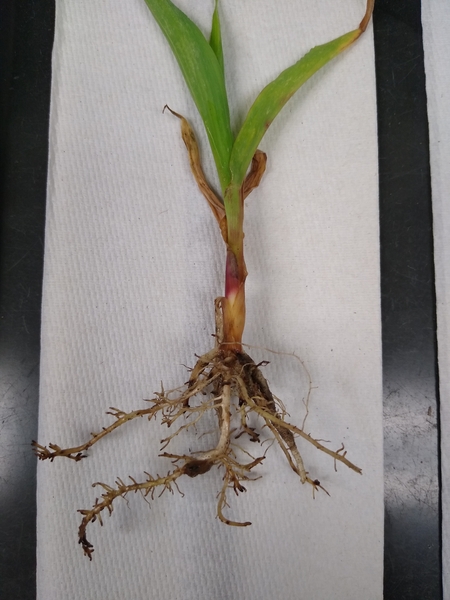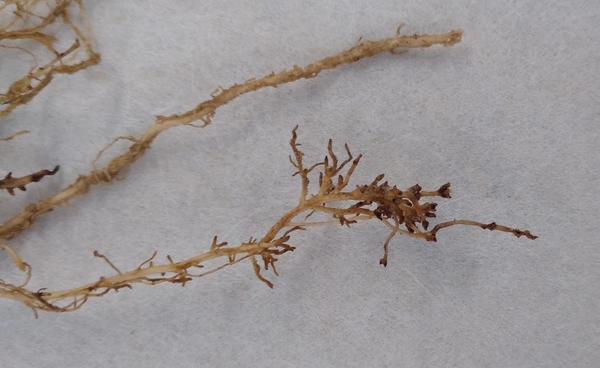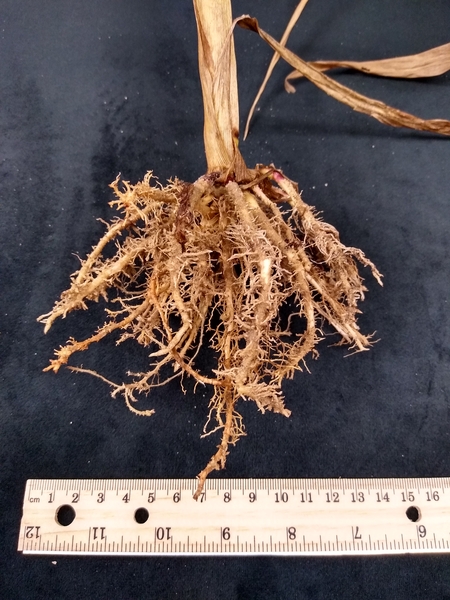Pathogen
Sting nematode (Belonolaimus longicaudatus) is an economically important ectoparasitic nematode that affects corn production in North Carolina. Sting nematode is more problematic in sandy soils (> 80% sand content) of the southeastern United States.
Signs & Symptoms
Aboveground symptoms of a sting nematode infection are often observed early in the growing season and vary depending on initial population density. Young plants may experience slow growth, reduced vigor, stunting and chlorosis, even under low initial populations of the nematode. If initial sting nematode populations are high, the plants may stop growing completely leading to a complete crop loss. A poor or patchy crop stand can often be indicative of a sting nematode infection (Figure 1).
Feeding damage from sting nematodes in the form of small brown-colored lesion may be observed on the roots of the plant (Figure 2, Figure 3). Sting nematodes feed on the root tips leading to a halt in growth; a stubby or abbreviated root system is characteristic of a sting nematode infection (Figure 4). As a result of the impaired root system, plants struggle to take up water and nutrients from the soil leading to aboveground symptoms and reductions in yield.
Disease Cycle
Sting nematodes are migratory ectoparasites, meaning they spend their lives in the soil feeding on the exterior of plant roots. Being a soil dwelling parasite, soil texture is extremely important factor influencing the distribution on sting nematode in the field. Sandy soils (sand content > 80%) with a constant supply of moisture are the preferred environment for sting nematode.
Like other plant-parasitic nematodes, sting nematodes begin as an egg and develops into the first (J1) and second (J2) of four juvenile stages before hatching. Once hatched, J2s move though soil to begin feeding on the plant roots. The nematodes continue to feed and develop into third-stage (J3) and fourth-stage (J4) juveniles, and finally into adults. Unlike other types of nematodes such as cyst nematodes or root-knot nematodes, adult sting nematodes remain worm-like in appearance and motile. Sting nematodes are amphimictic, meaning males and females must mate to produce viable offspring. Females begin laying eggs immediately after feeding which can lead to rapid population growth after peanuts are planted. The life cycle takes around 24-28 days when temperatures are optimum (25-30°C).
Diagnosis
Identifying if a field has a sting nematode infection is important for determining proper management strategies. Recognizing aboveground symptoms, especially early in the growing season, is an important for diagnosing the problem, yet once symptoms appear, it may be too late to initiate management tactics to protect the current crop. Sting nematode may cause considerable damage in corn and other crops, even at very low population numbers. Early diagnosis and active management of sting nematode can ensure fields remain productive for many years.
In order to properly identify which nematodes are causing problems in a field, soil and roots must be sampled and analyzed by a professional diagnostic laboratory or nematode assay laboratory. Soil samples for nematode assay services may be taken and sent to North Carolina Department of Agriculture & Consumer Services, Agronomic Services (NCDA&CS), Nematode Assay Laboratory, 4300 Reedy Creek Road, Raleigh, NC 27607.
In order to determine nematode pressure, soil samples should be collected from several areas in the affected field. Using a soil probe, collect 20 soil cores across a 5-acre block, at a depth of 6 to 8 inches from each area using a grid-like pattern or a zig-zag pattern across the field. Combine soil cores in a clean plastic bucket and remove a smaller portion of soil from this larger sample to submit to the Nematode Assay Laboratory. More detailed sampling instructions can be found at the NCDA&CS Nematode Assay Laboratory sampling guidelines.
Management
In corn and many other crops, sting nematode has a low economic threshold, that is, the number of nematodes that may be tolerated before crop damage and yield loss is suffered. If a field is known to have a sting nematode problem some management actions can be taken to control the pest and reduce its impact on the crop. Cultural controls such as crop rotation can prove effective for reducing sting nematode populations in the field. Table 1 provides a list of known host and non-host plants to sting nematode. Sting nematodes have no long-term survival stage, so populations decline rapidly when a field is fallow or a non-host crop is planted. Weed management can also help reduce available hosts for sting nematode to survive on (Table 1).
| Crop Type | Host Plant |
|---|---|
| Turf Crops and Grasses | Bahia, Bermuda, Bentgrass, Bluegrass, Centipedegrass, Fescue, Pangola Grass, St. Augustine |
| Field Crops | Barley, Clovers, Corn, Cotton, Lespedeza, Millet, Oats Peanut, Rye, Soybean, Wheat |
| Fruit and Vegetable Crops | Beans, Cabbage, Cantaloupe, Carrots, Cauliflower, Celery, Cowpea, Citrus, Cucumber, Eggplant, Endive, Lettuce, Okra, Onion, Pea, Snap bean, Squash, Strawberry, Sweet corn, Sweet potato, Tomato, Turnip |
| Cover Crops | Hairy vetch, Iron Clay pea, Joint vetch, Mung bean, Pigeon pea, Sesbania, Sudan grass |
| Common Weeds | Beggarweed Bermuda, Crabgrass, Cudweed, Dogfennel, Fescues, Johnsongrass, Lambsquarter, Ragweed, Spanish needle, Wild carrot |
| Crop Type | Non-Host Plants |
| Vegetable and Cover Crops | Asparagus, Crotalaria, Hairy Indigo, Hot pepper, Sunn hemp, Sorrel, Tobacco, Velvet bean, Watermelon |
| Common Weeds | Buckhorn plantain, Cocklebur, Horseweed, Jerusalem oak, Jimson weed, Pokeweed, Sandbur, Wild garlic |
Chemical management is an effective tool for managing existing sting nematode populations. Contact nematicides often work well on sting nematodes since they are free-living in the soil; however, individual application efficacy frequently depends on site-, application-, and environmental-specific factors. Chemical nematicide treatments are summarized in Table 2 and additional information may be found in the North Carolina Agricultural Chemicals Manual. Prior to selecting and using a nematicide, check the product’s registration and follow all label application instructions.
| Active ingredient and formulation | Amount | Notes |
|---|---|---|
|
terbufos (Counter 20 G) |
5.0 lb/ac |
Apply in furrow. Do not exceed 6.5 lb/ac of Counter 20 G |
|
ethoprop (Mocap 15 G) |
Consult label |
Apply 3 days before planting or at-plant |
|
abamectin (Avicta) |
0.15 mg per seed |
Seed treatment |
|
clothianidin 40.3% + Bacillus firmus I-1582 8.1% (Poncho/Votivo) |
0.25 to 0.50 mg per seed |
Seed treatment |
|
Bacillus amyloliquefaciens Strain PTA-4838 16.5% (Aveo EZ) |
0.1 fl oz per 80,000 seed |
Seed treatment |
|
Heat-killed Burkholderia spp. strain A396 94.46% (BioST) |
8 oz per 100 lb seed |
Seed treatment |
Additional Resources
The NCDA&CS Nematode Assay Lab provides soil detection and diagnostics
The NC State University Plant Disease and Insect Clinic provides diagnostic and management recommendations
The NC State Extension Plant Pathology portal provides information on crop disease management
The Southeastern US Vegetable Crop Handbook provides information on vegetable disease management
The North Carolina Agricultural Chemicals Manual provides an up-to-date list of chemicals available for control of nematodes and other diseases and pests
Acknowledgements
This factsheet was prepared by the NC State University Plant Nematology Lab in 2022.
Publication date: Nov. 30, 2022
N.C. Cooperative Extension prohibits discrimination and harassment regardless of age, color, disability, family and marital status, gender identity, national origin, political beliefs, race, religion, sex (including pregnancy), sexual orientation and veteran status.
NC Cooperative Extension prohíbe la discriminación por raza, color, nacionalidad, edad, sexo (incluyendo el embarazo), discapacidad, religión, orientación sexual, identidad de género, información genética, afiliación política, y estatus de veteran.
Recommendations for the use of agricultural chemicals are included in this publication as a convenience to the reader. The use of brand names and any mention or listing of commercial products or services in this publication does not imply endorsement by NC State University or N.C. A&T State University nor discrimination against similar products or services not mentioned. Individuals who use agricultural chemicals are responsible for ensuring that the intended use complies with current regulations and conforms to the product label. Be sure to obtain current information about usage regulations and examine a current product label before applying any chemical. For assistance, contact your local N.C. Cooperative Extension county center.
N.C. Cooperative Extension prohibits discrimination and harassment regardless of age, color, disability, family and marital status, gender identity, national origin, political beliefs, race, religion, sex (including pregnancy), sexual orientation and veteran status.




